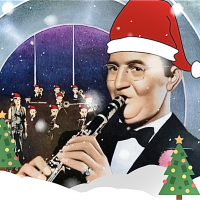Home » Jazz Musicians » Roy Eldridge
Roy Eldridge

Roy David Eldridge was a jazz trumpet player in the Swing era. His sophisticated use of harmony, including the use of tritone substitutions, resulted in him sometimes being seen as the link between Louis Armstrong-era swing music and Dizzy Gillespie-era bebop. Roy's rhythmic power to swing a band was a dynamic tradmark of the Swing Era.
Eldridge was born in Pittsburgh, Pennsylvania. His nickname was Little Jazz. Eldridge played in the bands of Fletcher Henderson, Gene Krupa and Artie Shaw before making records under his own name. He also played in Benny Goodman's and Count Basie's Orchestras, and co-led a band with Coleman Hawkins.
Also known as “Little Jazz” Roy Eldridge was a fiery, energetic trumpeter who although short in stature was a larger-than-life figure in the jazz trumpet lineage. Stylistically speaking he was the bridge between the towering trumpet stylists Louis Armstrong and Dizzy Gillespie. One of a significant number of jazz greats from the city of Pittsburgh, Roy’s first teacher was his alto saxophonist older brother Joe. Some of the great rhythmic drive of Eldridge’s later trumpet exploits could be traced to his beginnings on the drums, which he began playing at age six. His first professional work came at age 16 when he worked with a touring carnival, playing drums, trumpet, and tuba.
As a trumpeter Roy had come under the spell of Louis Armstrong’s irrisistable style. Among his earliest band affiliations were Oliver Muldoon, Horace Henderson, Zack Whyte, Speed Webb, and his own band, under the banner of Roy Elliott and his Palais Royal Orchestra. In 1930 he made the move to New York and headed straight to Harlem, where he gained work with a number of dance bands, among which was the Teddy Hill band. He left New York in 1934 to join the Michigan-based McKinney’s Cotton Pickers alongside such significant players as tenor man Chu Berry. Roy returned to New York to rejoin Teddy Hill in 1935, with whom he made his first recordings as a soloist in 1935. Prior to recording with Hill he toured with the Connie’s Hot Chocolates revue. After he left Hill’s band he became the lead trumpeter in Fletcher Henderson’s orchestra where his upper register abilities were highlighted. It didn’t take long for Eldridge to exert himself as a bandleader, forming his own octet in 1936 in Chicago; a band which included his brother Joe.
Eldridge recorded with the Three Deuces group, then left music for a short time to pursue radio engineering, an interesting twist considering his Chicago group’s nightly radio broadcasts. By the end of the 1930s after freelancing with such a wide array of bands Eldridge had gained notice as one of the swing bands’ most potent soloists. In 1941 he joined drummer Gene Krupa’s band. Not only did he provide trumpet fireworks for Krupa’s outfit he also sang, recording a memorable duet with the band’s female singer, Anita O’Day (NEA Jazz Master 1997) on the tune “Let Me Off Uptown” in 1941. Later, after Krupa’s band disbanded in 1943, and a period of freelancing, he toured with the Artie Shaw band in 1944. After Shaw it was time for Roy to lead his own big band, though economics forced him back to small swing groups.
Read moreTags
Roy Eldridge: In Paris

by Thomas Carroll
Roy EldridgeIn ParisVogue1951Trumpeter Roy Eldridge left the United States for Paris in 1950 fearing that the emergence of bebop, which he had strongly influenced, would make his more traditional style of playing obsolete and lose him his formerly adoring audiences. Eldridge did not stay in Paris for as long as some of his colleagues, but he managed to produce some fine, swinging recordings during his time abroad. In Paris documents two vibrant, ...
Continue ReadingRoy Eldridge: Coleman Hawkins and Roy Eldridge All-Stars at Newport

by Samuel Chell
After the triumphant, news-making appearance by the Duke Ellington Orchestra the preceding year, the 1957 Newport Jazz Festival was eagerly awaited by Verve impresario Norman Granz, no doubt hopeful of replicating the success of the best-selling album of Ellington's entire career (Ellington at Newport 1956 Complete, Columbia/Legacy). Although Verve's releases marking the 50th anniversary of the mother of all jazz festivals don't disappoint, there's much that's unlikely to strike the present-day listener as essential or even historic.The Coleman ...
Continue ReadingRoy Eldridge, Little Jazz Giant

by Mark Rattner
Roy Eldridge, Little Jazz GiantAuthor: John ChiltonContinuum, August 2002456 pages, photos: 18 b/w halftonesISBN 0-8264-5692-8Known for his dazzling improvisational skills and intensely competitive nature, Roy Eldridge is generally regarded as a key instrumentalist of the swing era. His extroverted, virtuoso style influenced a generation of swing trumpeters and paved the way for many bebop innovators including Dizzy Gillespie, Kenny Dorham and Dexter Gordon. A new biography, Roy Eldridge, Little Jazz ...
Continue ReadingRoy Eldridge: Decidedly

by Derek Taylor
Norman Granz, legendary label impresario and concert organizer, had his own niche in the Seventies. Take an aging, but estimable swing star; match him with a band built on the talents of younger players; incite some sparks through friendly rivalries both manufactured and genuine; apply some promotional spin and watch the greenbacks roll in. Such was presumably the case with this until now unreleased concert recording financed and produced by Granz for a French audience under the auspices of his ...
Continue ReadingBackgrounder: The Strolling Mr. Eldridge, 1953

Source:
JazzWax by Marc Myers
In December 1953, trumpeter Roy “Little Jazz" Eldridge recorded The Strolling Mr. Eldridge for Norman Granz's Clef label. Eldridge was a member of Granz's Jazz at the Philharmonic tour and recording group of all stars. The album was released during the “speed wars," when Columbia's 33 1/3 and RCA's 45 rpm formats were in fierce competition. Many labels issued albums on both speeds to cover their bases. Both formats would survive the battle—the 33 1/3 for LPs and 45s for ...
read more
Jazz Musician of the Day: Roy Eldridge

Source:
Michael Ricci
All About Jazz is celebrating Roy Eldridge's birthday today!
Roy David Eldridge was a jazz trumpet player in the Swing era. His sophisticated use of harmony, including the use of tritone substitutions, resulted in him sometimes being seen as the link between Louis Armstrong-era swing music and Dizzy Gillespie-era bebop. Roy's rhythmic power to swing a band was a dynamic tradmark of the Swing Era. Eldridge was born in Pittsburgh, Pennsylvania. His nickname was Little Jazz. Eldridge played in the ...
read more
Jazz Musician of the Day: Roy Eldridge

Source:
Michael Ricci
All About Jazz is celebrating Roy Eldridge's birthday today!
Roy David Eldridge was a jazz trumpet player in the Swing era. His sophisticated use of harmony, including the use of tritone substitutions, resulted in him sometimes being seen as the link between Louis Armstrong-era swing music and Dizzy Gillespie-era bebop. Roy's rhythmic power to swing a band was a dynamic tradmark of the Swing Era. Eldridge was born in Pittsburgh, Pennsylvania. His nickname was Little Jazz. Eldridge played in the ...
read more
Jazz Musician of the Day: Roy Eldridge

Source:
Michael Ricci
All About Jazz is celebrating Roy Eldridge's birthday today!
Roy David Eldridge was a jazz trumpet player in the Swing era. His sophisticated use of harmony, including the use of tritone substitutions, resulted in him sometimes being seen as the link between Louis Armstrong-era swing music and Dizzy Gillespie-era bebop. Roy's rhythmic power to swing a band was a dynamic tradmark of the Swing Era. Eldridge was born in Pittsburgh, Pennsylvania. His nickname was Little Jazz. Eldridge played in the ...
read more
Jazz Musician of the Day: Roy Eldridge

Source:
Michael Ricci
All About Jazz is celebrating Roy Eldridge's birthday today!
Roy David Eldridge was a jazz trumpet player in the Swing era. His sophisticated use of harmony, including the use of tritone substitutions, resulted in him sometimes being seen as the link between Louis Armstrong-era swing music and Dizzy Gillespie-era bebop. Roy's rhythmic power to swing a band was a dynamic tradmark of the Swing Era. Eldridge was born in Pittsburgh, Pennsylvania. His nickname was Little Jazz. Eldridge played in the ...
read more
Jazz Musician of the Day: Roy Eldridge

Source:
Michael Ricci
All About Jazz is celebrating Roy Eldridge's birthday today!
Roy David Eldridge was a jazz trumpet player in the Swing era. His sophisticated use of harmony, including the use of tritone substitutions, resulted in him sometimes being seen as the link between Louis Armstrong-era swing music and Dizzy Gillespie-era bebop. Roy\'s rhythmic power to swing a band was a dynamic tradmark of the Swing Era. Eldridge was born in Pittsburgh, Pennsylvania. His nickname was Little Jazz... Read more.
Place our ...
read more
Jazz Musician of the Day: Roy Eldridge

Source:
Michael Ricci
All About Jazz is celebrating Roy Eldridge's birthday today!
Roy David Eldridge was a jazz trumpet player in the Swing era. His sophisticated use of harmony, including the use of tritone substitutions, resulted in him sometimes being seen as the link between Louis Armstrong-era swing music and Dizzy Gillespie-era bebop. Roy\'s rhythmic power to swing a band was a dynamic tradmark of the Swing Era. Eldridge was born in Pittsburgh, Pennsylvania. His nickname was Little Jazz... Read more.
Place our ...
read more
Jazz Musician of the Day: Roy Eldridge

Source:
Michael Ricci
All About Jazz is celebrating Roy Eldridge's birthday today!
Roy David Eldridge was a jazz trumpet player in the Swing era. His sophisticated use of harmony, including the use of tritone substitutions, resulted in him sometimes being seen as the link between Louis Armstrong-era swing music and Dizzy Gillespie-era bebop. Roy\'s rhythmic power to swing a band was a dynamic tradmark of the Swing Era. Eldridge was born in Pittsburgh, Pennsylvania. His nickname was Little Jazz... Read more.
Place our ...
read more
Jazz Musician of the Day: Roy Eldridge

Source:
Michael Ricci
All About Jazz is celebrating Roy Eldridge's birthday today!
Roy David Eldridge was a jazz trumpet player in the Swing era. His sophisticated use of harmony, including the use of tritone substitutions, resulted in him sometimes being seen as the link between Louis Armstrong-era swing music and Dizzy Gillespie-era bebop. Roy\'s rhythmic power to swing a band was a dynamic tradmark of the Swing Era. Eldridge was born in Pittsburgh, Pennsylvania. His nickname was Little Jazz... Read more.
Place our ...
read more
Jazz Musician of the Day: Roy Eldridge

Source:
Michael Ricci
All About Jazz is celebrating Roy Eldridge's birthday today! Roy David Eldridge was a jazz trumpet player in the Swing era. His sophisticated use of harmony, including the use of tritone substitutions, resulted in him sometimes being seen as the link between Louis Armstrong-era swing music and Dizzy Gillespie-era bebop. Roy\'s rhythmic power to swing a band was a dynamic tradmark of the Swing Era. Eldridge was born in Pittsburgh, Pennsylvania. His nickname was Little Jazz... Read more. Place our ...
read more











































